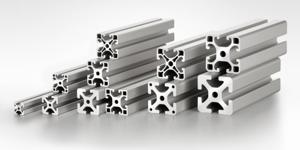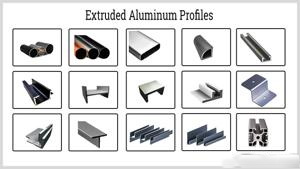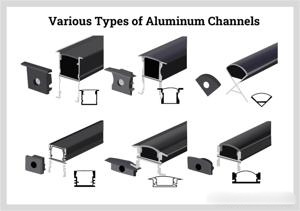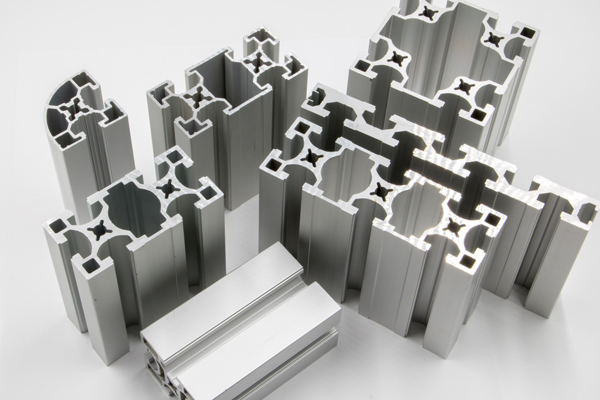Content Menu
● Introduction
● What Are Aluminum Extrusion Channel Profiles?
● The Extrusion Process
● Advantages of Aluminum Extrusion Channel Profiles
>> 1. Strength-to-Weight Ratio
>> 2. Corrosion Resistance
>> 3. Design Flexibility
>> 4. Cost-Effectiveness
>> 5. Sustainability
● Applications of Aluminum Extrusion Channel Profiles
>> Construction and Architecture
>> Transportation
>> Industrial Equipment
>> Consumer Products
● Choosing the Right Aluminum Extrusion Channel Profile
>> 1. Load Requirements
>> 2. Environmental Conditions
>> 3. Aesthetic Requirements
>> 4. Assembly Method
>> 5. Budget Constraints
● Surface Treatments for Aluminum Extrusion Channel Profiles
>> Anodizing
>> Powder Coating
>> Brushing and Polishing
● Custom Aluminum Extrusion Channel Profiles
● Innovations in Aluminum Extrusion Technology
>> Multi-Hole Dies
>> Micro-Extrusion
>> 3D Printed Dies
● Maintenance and Care of Aluminum Extrusion Channel Profiles
● Future Trends in Aluminum Extrusion Channel Profiles
>> Lightweight Design
>> Smart Profiles
>> Sustainable Production
>> Hybrid Materials
● Conclusion
● Frequently Asked Questions
>> 1. What are the most common aluminum alloys used for extrusion channel profiles?
>> 2. How do aluminum extrusion channel profiles compare to steel in terms of strength?
>> 3. Can aluminum extrusion channel profiles be welded?
>> 4. How long do aluminum extrusion channel profiles typically last?
>> 5. Are there any limitations to the size of aluminum extrusion channel profiles that can be produced?
Introduction
Aluminum extrusion channel profiles have become increasingly popular in various industries due to their versatility, durability, and cost-effectiveness. These profiles offer a unique combination of strength, lightweight design, and corrosion resistance, making them an ideal choice for construction, manufacturing, and even DIY projects. In this comprehensive guide, we'll explore the numerous benefits of aluminum extrusion channel profiles and why they might be the perfect solution for your next project.

What Are Aluminum Extrusion Channel Profiles?
Aluminum extrusion channel profiles are long, extruded shapes made from aluminum alloys. They are formed through a process called extrusion, where molten aluminum is forced through a die to create a specific cross-sectional shape. This process allows for the creation of intricate profiles with consistent dimensions, ensuring structural integrity and ease of use.
The most common types of aluminum extrusion channel profiles include:
1. U-channel
2. C-channel
3. H-channel
4. Z-channel
5. Hat channel
Each of these profiles has its unique characteristics and applications, which we'll explore in more detail throughout this article.
The Extrusion Process
To fully appreciate the benefits of aluminum extrusion channel profiles, it's essential to understand the extrusion process. Here's a step-by-step breakdown:
1. Billet Preparation: Aluminum alloy is cast into a cylindrical billet.
2. Heating: The billet is heated to around 900°F (482°C) to make it malleable.
3. Extrusion: The heated billet is placed in a container and pushed through a die using a hydraulic ram.
4. Cooling: The extruded profile is cooled using air or water quenching.
5. Stretching: The profile is stretched to straighten it and relieve internal stresses.
6. Cutting: The profile is cut to the desired length.
7. Heat Treatment: The profile undergoes heat treatment to achieve the desired strength and hardness.
8. Finishing: Optional surface treatments like anodizing or powder coating are applied.
This video provides an in-depth look at the aluminum extrusion process, showcasing the precision and efficiency involved in creating these versatile profiles.
Advantages of Aluminum Extrusion Channel Profiles
1. Strength-to-Weight Ratio
One of the most significant advantages of aluminum extrusion channel profiles is their exceptional strength-to-weight ratio. Aluminum is approximately one-third the weight of steel, yet it can provide comparable strength in many applications. This makes aluminum profiles ideal for projects where weight reduction is crucial, such as in the automotive and aerospace industries.
2. Corrosion Resistance
Aluminum naturally forms a protective oxide layer when exposed to air, making it highly resistant to corrosion. This property is particularly beneficial for outdoor applications or environments with high humidity or exposure to chemicals.
3. Design Flexibility
The extrusion process allows for the creation of complex shapes and profiles that would be difficult or impossible to achieve with other manufacturing methods. This flexibility enables designers and engineers to create custom profiles tailored to specific project requirements.
4. Cost-Effectiveness
While the initial cost of aluminum may be higher than some other materials, the overall cost-effectiveness of aluminum extrusion channel profiles is often superior. Factors contributing to this include:
- Lower transportation costs due to lighter weight
- Reduced maintenance requirements
- Longer lifespan due to corrosion resistance
- Ability to create complex shapes in a single process, reducing assembly costs
5. Sustainability
Aluminum is 100% recyclable without loss of quality, making it an environmentally friendly choice. The recycling process for aluminum requires only 5% of the energy needed to produce primary aluminum, significantly reducing its carbon footprint.
Applications of Aluminum Extrusion Channel Profiles
The versatility of aluminum extrusion channel profiles makes them suitable for a wide range of applications across various industries:
Construction and Architecture
In the construction industry, aluminum extrusion channel profiles are widely used for:
- Window and door frames
- Curtain walls
- Structural framing
- Railings and handrails
- Solar panel mounting systems
Transportation
The automotive and aerospace industries benefit from aluminum profiles in:
- Vehicle body frames
- Truck and trailer bodies
- Bus structures
- Aircraft interiors
Industrial Equipment
Many industrial applications utilize aluminum extrusion channel profiles, including:
- Conveyor systems
- Machine guards
- Workstations and assembly lines
- Clean room environments
Consumer Products
Aluminum profiles are also found in various consumer products:
- Furniture
- Shower enclosures
- Display stands
- Lighting fixtures

Choosing the Right Aluminum Extrusion Channel Profile
Selecting the appropriate aluminum extrusion channel profile for your project involves considering several factors:
1. Load Requirements
Determine the load-bearing requirements of your application. Different profile shapes and sizes offer varying levels of strength and rigidity. For example, I-beam profiles are excellent for supporting heavy loads, while C-channels are ideal for framing and structural support.
2. Environmental Conditions
Consider the environment in which the profile will be used. For outdoor or corrosive environments, you may need to select a specific alloy or surface treatment. Marine-grade alloys like 5052 or 6061-T6 are excellent choices for coastal or high-humidity areas.
3. Aesthetic Requirements
If the profile will be visible in the final product, consider the desired appearance. Aluminum profiles can be anodized or powder coated in various colors and finishes. Brushed or polished finishes can create a modern, industrial look, while wood-grain powder coatings can mimic the appearance of natural materials.
4. Assembly Method
Think about how the profile will be assembled or joined with other components. Some profiles are designed with specific joining methods in mind, such as T-slot profiles for easy bolt-on connections. Others may be better suited for welding or adhesive bonding.
5. Budget Constraints
While aluminum extrusion channel profiles are generally cost-effective, consider your budget when selecting profiles and finishes. Standard profiles are typically more affordable than custom extrusions, and certain surface treatments may add to the overall cost.
Surface Treatments for Aluminum Extrusion Channel Profiles
To enhance the performance and appearance of aluminum extrusion channel profiles, various surface treatments can be applied:
Anodizing
Anodizing is an electrochemical process that creates a durable, corrosion-resistant oxide layer on the aluminum surface. It can also be used to add color to the profile. Anodized finishes are available in a range of colors and can provide excellent wear resistance.
Powder Coating
Powder coating involves applying a dry powder to the aluminum surface and then curing it under heat. This creates a durable, attractive finish available in a wide range of colors. Powder coating offers excellent chemical and UV resistance, making it ideal for outdoor applications.
Brushing and Polishing
For a more industrial or modern look, aluminum profiles can be brushed or polished to create a smooth, reflective surface. These finishes can highlight the natural beauty of the aluminum while providing a sleek, contemporary appearance.
Custom Aluminum Extrusion Channel Profiles
While standard profiles are suitable for many applications, custom extrusion profiles can be designed to meet specific project requirements. The process of creating a custom profile typically involves:
1. Design consultation with an extrusion specialist
2. CAD drawing and profile optimization
3. Die design and manufacturing
4. Sample extrusion and testing
5. Full production run
Custom profiles can incorporate features such as:
- Integrated fastening systems
- Wire management channels
- Interlocking mechanisms
- Specialized surface textures

Innovations in Aluminum Extrusion Technology
The field of aluminum extrusion is constantly evolving, with new technologies and techniques emerging to improve the quality, efficiency, and capabilities of the extrusion process. Some recent innovations include:
Multi-Hole Dies
Multi-hole dies allow for the simultaneous extrusion of multiple profiles, increasing production efficiency and reducing costs. This technology is particularly useful for high-volume production of smaller profiles.
Micro-Extrusion
Advancements in die design and extrusion technology have made it possible to produce extremely small and intricate profiles, opening up new possibilities in industries such as electronics and medical devices.
3D Printed Dies
The use of 3D printing technology to create extrusion dies has reduced lead times and costs for custom profile production, making it more accessible for smaller projects and prototyping.
Maintenance and Care of Aluminum Extrusion Channel Profiles
Proper maintenance can significantly extend the life of aluminum extrusion channel profiles and ensure optimal performance. Some key maintenance tips include:
- Regular cleaning with mild soap and water to remove dirt and debris
- Avoiding harsh chemicals that could damage the surface finish
- Inspecting profiles periodically for signs of wear or damage
- Lubricating moving parts in assemblies using profiles
- Touching up any scratches or chips in the surface finish to prevent corrosion
Future Trends in Aluminum Extrusion Channel Profiles
As technology advances and environmental concerns become more pressing, several trends are emerging in the aluminum extrusion industry:
Lightweight Design
The automotive and aerospace industries are driving demand for even lighter and stronger aluminum alloys and profile designs to improve fuel efficiency and performance.
Smart Profiles
Integration of sensors and electronic components directly into aluminum profiles is becoming more common, enabling smart building systems and IoT applications.
Sustainable Production
Increased focus on reducing the carbon footprint of aluminum production through the use of renewable energy sources and improved recycling processes.
Hybrid Materials
Development of composite profiles that combine aluminum with other materials like carbon fiber or thermoplastics to achieve specific performance characteristics.
Conclusion
Aluminum extrusion channel profiles offer a unique combination of strength, versatility, and cost-effectiveness that make them an excellent choice for a wide range of projects. From construction and transportation to industrial equipment and consumer products, these profiles provide solutions to complex design challenges while offering benefits such as lightweight construction, corrosion resistance, and sustainability.
As technology advances and new alloys are developed, the potential applications for aluminum extrusion channel profiles continue to expand. Whether you're working on a large-scale construction project or a small DIY endeavor, considering aluminum extrusion channel profiles could lead to innovative solutions and improved outcomes.
By understanding the extrusion process, the various profile types available, and the factors to consider when selecting profiles, you can make informed decisions that will enhance the success of your projects. As we move towards a future that demands more sustainable and efficient building practices, aluminum extrusion channel profiles are poised to play an increasingly important role in shaping our built environment.
The continuous innovation in aluminum extrusion technology, coupled with the material's inherent benefits, ensures that aluminum extrusion channel profiles will remain a go-to solution for engineers, architects, and designers for years to come. By embracing these versatile components, you can unlock new possibilities in design, efficiency, and sustainability across a wide range of applications.

Frequently Asked Questions
1. What are the most common aluminum alloys used for extrusion channel profiles?
The most commonly used aluminum alloys for extrusion channel profiles are:
- 6061: Known for its excellent strength and corrosion resistance, this alloy is often used in structural applications.
- 6063: This alloy offers good extrudability and surface finish, making it popular for architectural applications.
- 7075: While more challenging to extrude, this alloy provides superior strength and is often used in aerospace applications.
2. How do aluminum extrusion channel profiles compare to steel in terms of strength?
While steel is generally stronger than aluminum, aluminum extrusion channel profiles can be designed to provide comparable strength in many applications. The key advantages of aluminum include:
- Lower weight (about one-third the weight of steel)
- Better corrosion resistance
- Ability to create more complex shapes through extrusion
In applications where weight reduction is crucial, aluminum profiles can often provide a better strength-to-weight ratio than steel.
3. Can aluminum extrusion channel profiles be welded?
Yes, aluminum extrusion channel profiles can be welded using various methods, including:
- TIG (Tungsten Inert Gas) welding
- MIG (Metal Inert Gas) welding
- Friction stir welding
However, welding aluminum requires specific skills and equipment due to its unique properties. It's essential to consider factors such as the alloy type, thermal conductivity, and potential for distortion when welding aluminum profiles.
4. How long do aluminum extrusion channel profiles typically last?
The lifespan of aluminum extrusion channel profiles depends on various factors, including:
- Environmental conditions
- Applied loads
- Maintenance practices
- Surface treatments
In general, properly designed and maintained aluminum profiles can last for decades. Their natural corrosion resistance contributes to their longevity, especially in outdoor applications. With appropriate care and protection, aluminum profiles can often outlast alternative materials in many environments.
5. Are there any limitations to the size of aluminum extrusion channel profiles that can be produced?
While aluminum extrusion allows for a wide range of profile sizes, there are some limitations:
- Cross-sectional area: Most extrusion presses have a maximum billet size, which limits the cross-sectional area of the profile.
- Length: The maximum length is typically determined by the handling capabilities of the extrusion plant and transportation constraints.
- Wall thickness: There are minimum and maximum wall thicknesses that can be achieved, depending on the alloy and profile design.























